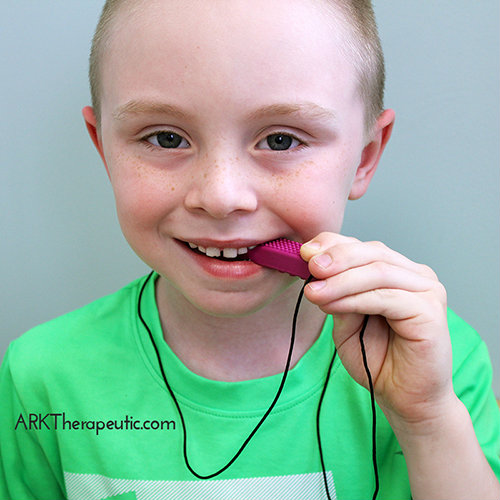Finger/Knuckle Biting & Chewing on Non-Food Items
Posted by Debra C. Lowsky, MS, CCC-SLP on 10th Jun 2011
Question: My son chews on his fingers so much! He has chewed right through the first layer of his skin on his index finger and thumb. Would Grabbers be good as an alternative for him to chew on, on his own? He is 4 years old, on the autism spectrum, and doesn't talk much. Thanks for your help! He really needs something else to keep him from getting sores.
Question: My 9-year-old chews on everything... erasers, the foam rubber that often covers remotes or exercise equipment, I have even caught him chewing styrofoam! He has always had an oral fixation since he was a toddler, putting rocks in his mouth and chewing on everything in sight. I've read on some discussion boards that your Grabbers are often used by other kids with the same issue. Looking for advice!
.
Dear parents,
I'm very glad you found us! First and foremost it is important to provide them with a safe outlet for chewing. About 17 years ago, I was working with a child whose parents were in the same position. It was specifically for this child (and now many others) that we decided to invent the Grabber and lots of other safe sensory chew tools.
.

.
All ARK chews (such as the Grabber, Y-Chew, Brick Stick, Krypto-Bite, and other chewelry) are made in the USA, medical grade, and designed to provide proprioceptive input to the lips, tongue, cheeks, and jaw during chewing. Very importantly, we have many shape options with long extensions to reach all the way to the back molar area where chewing is typically needed the most for input to the jaw.
They're also available in various textured versions for additional sensory stimulation, which is particularly great for sensory seekers that enjoy biting and chewing on fingers. And they come in 3 color-coded toughness levels for mild to moderate to avid chewing needs.

Each time your child reaches for an inappropriate item to chew on, replace it with an ARK chew. Be consistent and patient. It also helps to get everyone involved in the redirecting (babysitters, siblings, grandparents, etc.) for the best results, at least until it “sticks."
.

.
Please note, however, that although it's very important to provide them with a safe outlet to chew on, that may not be the only intervention needed. For example, they may also benefit from gum massage. And it may be helpful to incorporate more harder-to-chew foods into their diets, such as apples, carrots, celery, etc. This will hopefully help provide more of that heavy jaw input they're likely seeking. For more oral sensory strategies, click here.
Most importantly, however, I recommend that they see an occupational therapist (OT) too for an evaluation to see if what’s called a “sensory diet” may be helpful.
For more information, check out this article about the reasons why some kids need to chew.
.
All my best,
Debbie
Debra C. Lowsky, MS, CCC-SLP
.

